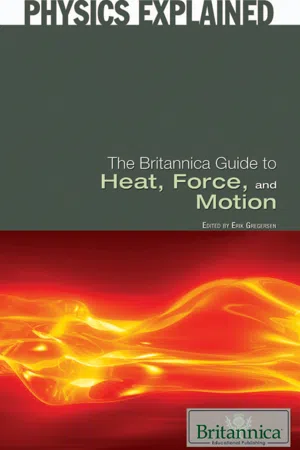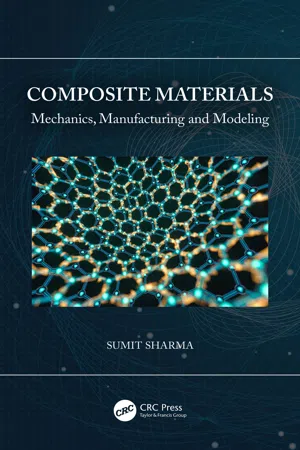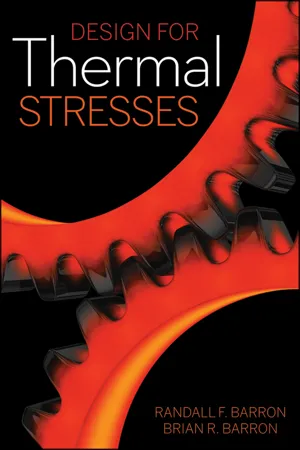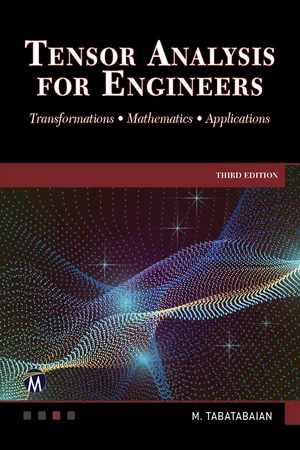Technology & Engineering
Stress Transformation Equations
Stress transformation equations are used in engineering to analyze how stress changes when a material is subjected to different loading conditions. These equations help engineers understand how forces applied to a material affect its internal stress distribution. By using stress transformation equations, engineers can predict how a material will respond to various types of loading, which is crucial for designing safe and efficient structures.
Written by Perlego with AI-assistance
Related key terms
Related key terms
1 of 4
Related key terms
1 of 3
6 Key excerpts on "Stress Transformation Equations"
- eBook - ePub
- StephenW. Tsai(Author)
- 2018(Publication Date)
- Routledge(Publisher)
Figure 2.2 , the components of stress and strain will change following prescribed patterns. This variation is called the transformation equation of stress and strain. The state of stress or strain remains the same, independent of the coordinate system, but the magnitude of its components change.In conventional materials, physical properties do not change with reference coordinates. This class of materials is isotropic. The transformation of stress or strain has no special meaning or utility with the exception of two special orientations; viz., the principal axes where the shear component vanishes, and the maximum shear orientation which is 45 degrees away from the principal axes. These special orientations are useful for conventional materials because a number of failure theories can be applied using the maximum principal stresses or the maximum shear stresses.In composite materials, we need to know the transformation equations of stress and strain for a number of reasons.First, the properties of composites are not isotropic. The state of stress or strain existing relative to the on-axis configuration is important in determining the stiffness and strength of composite materials. We can then use the transformation equations, for example, to find the on-axis stress from the applied stress in an off-axis orientation or vice versa.Secondly, transformation equations are needed to determine the principal stresses or strains. The same transformation equations also define the invariants of stress and strain. The concepts of principal axes and invariants are fundamental for the understanding of composite materials. The same concepts can be extended to those for stiffness and strength. They will be explained later.Finally, transformation equations for stress and strain, together with the on-axis stress-strain relations of Chapter 1 , can be used to determine the off-axis compliance and modulus of unidirectional composites. The sequence of operations is illustrated in Figure 2.3 - eBook - ePub
- Britannica Educational Publishing, Erik Gregersen(Authors)
- 2010(Publication Date)
- Britannica Educational Publishing(Publisher)
CHAPTER 7 STRESS AND STRAINI n addressing any problem in continuum or solid mechanics, three factors must be considered: (1) the Newtonian equations of motion, in the more general form recognized by Euler, expressing conservation of linear and angular momentum for finite bodies (rather than just for point particles), and the related concept of stress, as formalized by Cauchy, (2) the geometry of deformation and thus the expression of strains in terms of gradients in the displacement field, and (3) the relations between stress and strain that are characteristic of the material in question, as well as of the stress level, temperature, and time scale of the problem considered.These three considerations suffice for most problems. They must be supplemented, however, for solids undergoing diffusion processes in which one material constituent moves relative to another (which may be the case for fluid-infiltrated soils or petroleum reservoir rocks) and in cases for which the induction of a temperature field by deformation processes and the related heat transfer cannot be neglected. These cases require that the following also be considered: (4) equations for conservation of mass of diffusing constituents, (5) the first law of thermodynamics, which introduces the concept of heat flux and relates changes in energy to work and heat supply, and (6) relations that express the diffusive fluxes and heat flow in terms of spatial gradients of appropriate chemical potentials and of temperature. In many important technological devices, electric and magnetic fields affect the stressing, deformation, and motion of matter. Examples are provided by piezoelectric crystals and other ceramics for electric or magnetic actuators and by the coils and supporting structures of powerful electromagnets. In these cases, two more considerations must be added: (7) James Clerk Maxwell’s set of equations interrelating electric and magnetic fields to polarization and magnetization of material media and to the density and motion of electric charge, and (8) augmented relations between stress and strain, which now, for example, express all of stress, polarization, and magnetization in terms of strain, electric field, magnetic intensity, and temperature. The second law of thermodynamics, combined with the above-mentioned principles, serves to constrain physically allowed relations between stress, strain, and temperature in (3) and also constrains the other types of relations described in (6) and (8) above. Such expressions, which give the relationships between stress, deformation, and other variables, are commonly referred to as constitutive relations. - Josip Brnic(Author)
- 2018(Publication Date)
- Wiley(Publisher)
Equation (3.20) ). The above implies that the tensor components are symmetric with respect to the main diagonal of the tensor. There are fifteen unknowns in total. This means that one needs to have fifteen equations if the unknowns need to be derived. However, the theory of stress and the theory of strain are derived “in general”. This means that the theories have been derived independent of the material properties; that is, independent of the material from which the considered body is made. As such, the theory of stress is based on the equilibrium of forces while the theory of deformation is based on the compatibility of geometry. It is to be expected that the stress occurring in a body is associated with the deformation and the material properties. The question that arises is what the relationship between stress and strain is. It is very difficult to find universal equations that can be used to summarise the relationship between stress and strain for all of types of solid bodies, and especially if all of types of continuum are considered. If solid bodies are being considered, tests indicate that stress depends on strain, strain rate, temperature, time and other factors, and this fact can be expressed in the form:(7.1)In Equation (7.1) , εijrepresents strain; represents the strain rate; T represents temperature; t represents time; pi represents the material parameters. Equations of this type are known as constitutive equations. In many cases, for example in metallic materials, but also many others, Equation (7.1) may be written as:(7.2)If the problem involves the temperature, then the temperature distribution needs to be known or it needs to be solved for using the equation of heat transfer. However, compatibility conditions need to be fulfilled.Solid bodies, with regard to their responses, are usually divided into the following categories:- Elastic bodies
- Plastic bodies
- Viscoelastic bodies
- Viscoplastic bodies.
- Isotropic bodies
- Orthotropic bodies
- Anisotropic bodies.
In Section 5.1 some material responses were shown. Sometimes, relationships represented by Equations (7.1) and (7.2)- eBook - ePub
Composite Materials
Mechanics, Manufacturing and Modeling
- Sumit Sharma(Author)
- 2021(Publication Date)
- CRC Press(Publisher)
Chapter 9 . Equally important, though, is the fact that the transformation of the description of the stress–strain response of fiber-reinforced material from the principal material coordinate system to a global coordinate system results in concepts so different from what one encounters with isotropic materials that it is best to start with a simpler plane stress state and progress to the more complicated general stress state. When the concepts for the plane stress stress-state response described in a coordinate system other than the principal material coordinate system are fully understood, progression to a three-dimensional stress state is easier.8.1 Transformation Equations
Consider, as shown in Figure 8.1a , the familiar view of an isolated element in the principal material coordinate system. Figure 8.1b shows a similar element but one that is isolated in an x-y-z global coordinate system. The fibers are oriented at an angle θ with respect to the +x axis of the global system. The fibers are parallel to the x-y plane, and the 3 and z axes coincide. The fibers assumed their orientation by a simple rotation of the principal material system about the 3 axis. The orientation angle θ will be considered positive when the fibers rotate counterclockwise from the +x axis toward the +y axis. Often the fibers not being aligned with the edges of the element are referred to as an off-axis condition, generally meaning the fibers are not aligned with the analysis coordinate system (i.e., off the +x axis). Though we will use the notation for a rectangular Cartesian coordinate system as the global system (i.e., x-y-z ), the global coordinate system can be considered to be any orthogonal coordinate system. The use of a Cartesian system is for convenience only, and the development is actually valid for any orthogonal coordinate system [1 - eBook - ePub
- Randall F. Barron, Brian R. Barron(Authors)
- 2011(Publication Date)
- Wiley(Publisher)
Chapter 5 Basic Equations of Thermoelasticity 5.1 IntroductionIn the preceding chapters, we had used the so-called “strength of materials” approach in calculating thermal stresses and deformations. The restrictions on the strength of materials analysis are listed in Section 3.1. When plates are subjected to mechanical and thermal loading, the effect of lateral strain (Poisson's ratio effects) may be significant, since neglecting these effects result in errors of 10 percent or more in the calculated stress. In addition, the analysis was essentially one dimensional. Even in the case of bending stresses, the variation of the displacement in the direction perpendicular to the neutral axis was taken as a linear variation in the strength of materials approach.In this chapter, we will examine the fundamental equations for thermoelasticity. It is important to understand the restrictions on the basic equations. An extremely complicated analysis is meaningless if the basic equations used in the analysis are not applicable to the problem. Also, it is helpful in understanding the analysis if the physical meaning for the mathematical terms is understood.The basic thermoelasticity equations include (a) definitions of strain in terms of the displacements, (b) strain compatibility relations, (c) stress equilibrium relations (force balances), (d) stress–strain relations (generalized Hooke's law), and (e) the temperature field equations. Material property relations are also required in the solution of thermoelasticity problems, in general.In the discussion of the stress–strain relationships and temperature field equations in this chapter, we will consider only materials that may be considered homogeneous (the same material throughout) and isotropic (properties the same in all directions). For design purposes, many engineering materials may be treated as homogeneous and isotropic with little error. Materials such as wood, layered composites, and reinforced concrete are exceptions to this statement. - eBook - ePub
Tensor Analysis for Engineers
Transformations - Mathematics - Applications
- Mehrzad Tabatabaian(Author)
- 2023(Publication Date)
- Mercury Learning and Information(Publisher)
CHAPTER 16MECHANICAL STRESS TRANSFORMATION: ANALYTICAL AND MOHR’S CIRCLE METHODSIn Chapters 12 and 15 , we discussed the transformation of Cartesian tensors and their applications for rigid body rotations. In this section, we would like to expand on this topic in relation to transformation of mechanical-stress type tensors and an equivalent graphical method called Mohr’s circle.In engineering, there are quantities such as mechanical stress, strain, and moment of inertia that sometimes need to be transformed for material failure analysis and design purposes. The transformations follow the Cartesian tensors rule discussed in Chapters 12 and 7 .We define a 3D mechanical stress tensor, in matrix form, as with the first index of each element of the matrix being the direction of the plane outward normal and the second index the direction of the force acting on that plane. The positive stress is hence defined considering the outward normal and the coordinates selected (see Figs. 16.1 and 16.2 ). To simplify the notations, the stresses in the Normal direction are given with only one index (i.e., , , and ) and the shear stresses are assumed to be symmetric (i.e.,, , and ). Therefore, we have the symmetric stress matrix/tensor as, with six independent elements.FIGURE 16.1Plane stress sketch acting on the x - y plane with positive stress components.The coordinate system is arbitrary, and we define them to perform calculations in a consistent manner. We define the Cartesian coordinates at the origin in any desired direction, at a point of interest in the material geometrical domain. In the mechanics of solids, certain orientations of the coordinates system are preferred, since some materials show failure due the maximum normal or maximum shear stresses. Obviously, under any transformation, the magnitude of the stress tensor quantity does not change, only its components change.
Index pages curate the most relevant extracts from our library of academic textbooks. They’ve been created using an in-house natural language model (NLM), each adding context and meaning to key research topics.
Explore more topic indexes
Explore more topic indexes
1 of 6
Explore more topic indexes
1 of 4





